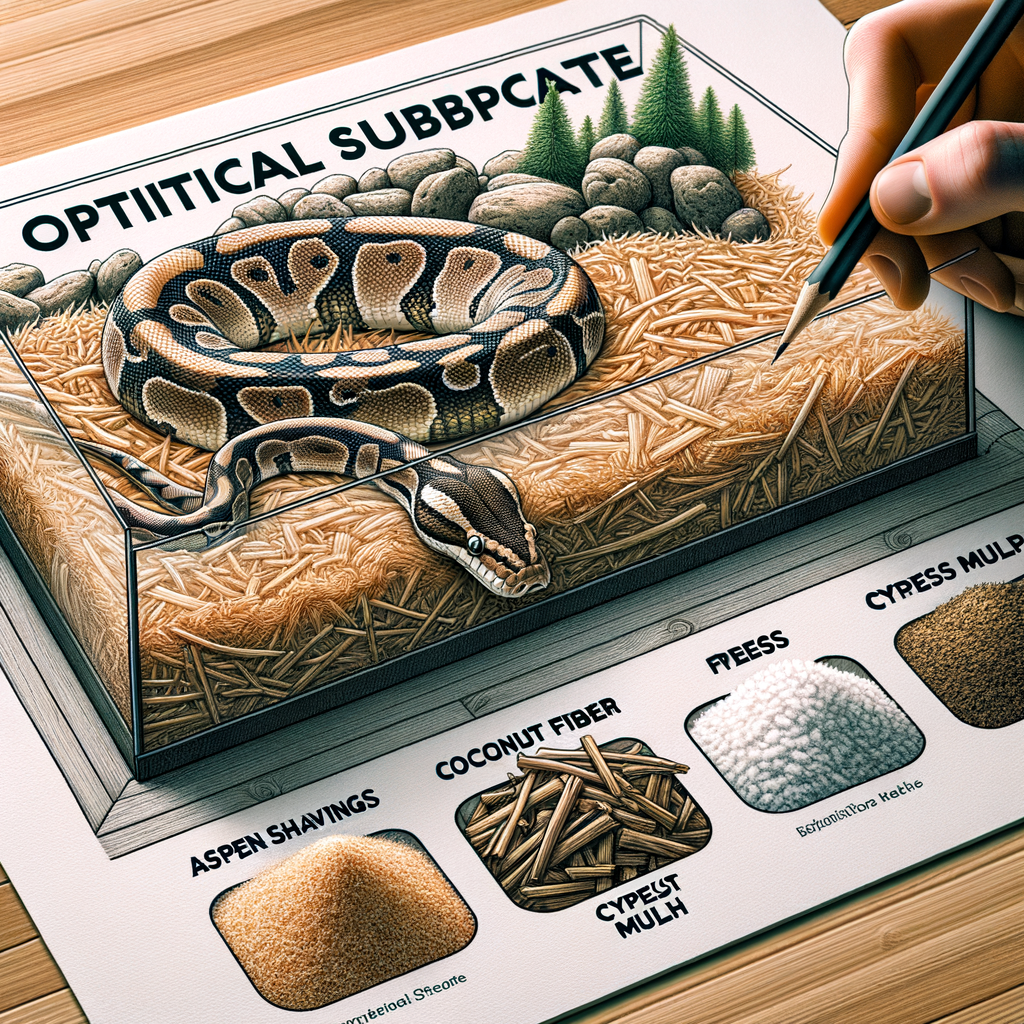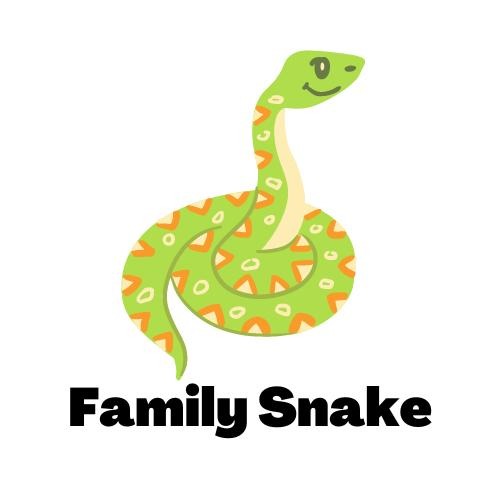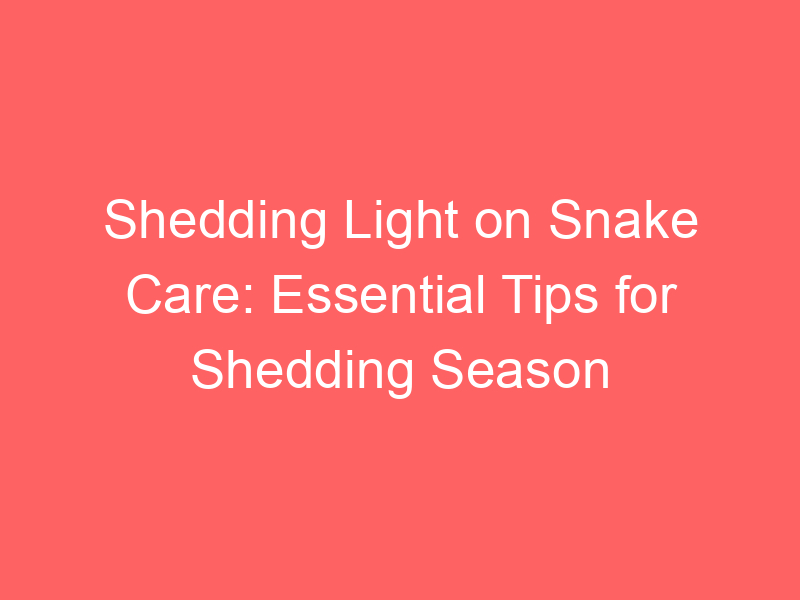
Introduction to Snake Enclosure Substrate
When it comes to creating a comfortable and healthy environment for your pet snake, one of the most important elements to consider is the substrate. The substrate, or bedding, plays a crucial role in your snake’s enclosure. It not only provides a naturalistic and aesthetically pleasing environment but also contributes significantly to the overall health and well-being of your pet snake.
- Understanding the Importance of Substrate in a Snake Enclosure
- How Substrate Contributes to a Snake’s Health and Well-being
The substrate in a snake enclosure is more than just a decorative element. It serves several essential functions that contribute to the snake’s overall health and comfort. The substrate helps to maintain the right humidity levels inside the enclosure, which is crucial for snakes as they shed their skin. It also provides a comfortable surface for the snake to move and rest on. Furthermore, certain types of substrate can aid in the snake’s natural behaviors, such as burrowing.
Choosing the right substrate can have a significant impact on your snake’s health. For instance, a substrate that retains moisture well can help prevent shedding problems, a common issue among captive snakes. In contrast, a substrate that is too dry or dusty can lead to respiratory issues. The substrate also plays a role in the snake’s mental well-being. Snakes are naturally curious creatures, and a substrate that allows for burrowing or provides interesting textures to explore can help keep your snake mentally stimulated.
In conclusion, the substrate is an essential part of a snake enclosure. It not only contributes to the physical health of the snake but also plays a role in their mental well-being. Therefore, it’s important to choose a substrate that is suitable for your specific type of snake and meets their individual needs.
Choosing Substrate for Snakes: Factors to Consider
When it comes to creating a comfortable and healthy environment for your pet snake, choosing the right substrate is crucial. There are several factors to consider when selecting the best substrate for your snake’s enclosure. Let’s delve into these factors:
- Snake species and their specific substrate requirements
- Humidity and temperature control
- Easy of cleaning and maintenance
- Cost and availability
Different snake species have different substrate requirements. For instance, Ball Pythons prefer substrates that can hold humidity well, like coconut fiber or cypress mulch. On the other hand, Corn Snakes, which are native to the southeastern United States, are comfortable with aspen shavings. It’s essential to research your snake’s natural habitat and choose a substrate that mimics it as closely as possible.
Humidity and temperature play a significant role in a snake’s health. Substrates like coconut fiber and cypress mulch are excellent for maintaining humidity levels. On the other hand, substrates like aspen shavings are better for snakes that require a drier environment. The substrate you choose should also be able to hold heat well to maintain the right temperature in the enclosure.
Keeping your snake’s enclosure clean is crucial for its health. Some substrates are easier to clean and maintain than others. For example, paper towels or newspaper are easy to replace and clean, but they don’t offer much in terms of aesthetics or natural behavior. On the other hand, substrates like aspen shavings or coconut fiber may require more effort to clean but provide a more natural environment for your snake.
Lastly, consider the cost and availability of the substrate. Some substrates, like newspaper or paper towels, are inexpensive and readily available. Others, like specialty reptile barks or mulches, may be more expensive and harder to find. Choose a substrate that fits your budget and is easily accessible to ensure your snake’s enclosure can be maintained properly.
In conclusion, the right substrate for your snake depends on its species, the humidity and temperature requirements, ease of cleaning and maintenance, and the cost and availability of the substrate. By considering these factors, you can create a comfortable and healthy environment for your pet snake.
Best Substrate for Snake Enclosures: Top Choices
When it comes to creating a comfortable and healthy environment for your pet snake, choosing the right substrate is crucial. Here, we will explore the top choices for snake enclosure substrates. These options have been selected based on their safety, ease of maintenance, and the comfort they provide to the snake.
- Cypress Mulch
- Aspen Shavings
- Coconut Fiber
- Newspaper and Paper Towels
Cypress mulch is a popular choice for many snake owners. It retains moisture well, which can help maintain the humidity levels in the enclosure. It’s also soft and comfortable for snakes to slither over. However, it’s important to ensure the mulch is free from pesticides and other chemicals that could harm your snake.
Aspen shavings are another excellent choice for a snake enclosure. They are absorbent, easy to clean, and provide a natural-looking environment. Aspen shavings are also dust-free, which is beneficial for the respiratory health of your snake. However, they do not retain moisture as well as cypress mulch, so they may not be the best choice for species that require high humidity.
Coconut fiber, also known as coir, is a substrate that is gaining popularity among snake owners. It’s excellent at retaining moisture and helps maintain a stable humidity level in the enclosure. It’s also soft and comfortable for snakes. Coconut fiber is also eco-friendly, as it’s a renewable resource.
For those on a budget or looking for a simple and easy-to-clean substrate, newspaper and paper towels are a viable option. They don’t retain moisture or contribute to the enclosure’s aesthetics, but they are cheap, readily available, and easy to replace. This makes them a good choice for quarantine enclosures or for snake species that do not require high humidity levels.
Remember, the best substrate for your snake will depend on its specific needs and preferences. Always monitor your snake’s behavior and health to ensure the substrate you choose is working well for them.
Snake Habitat Substrate: Case Studies
In this section, we will delve into real-life case studies to better understand the importance of choosing the right substrate for your snake’s habitat. Our first case study focuses on the Ball Python and its preference for Cypress Mulch.
Case Study 1: Ball Python and Cypress Mulch
Ball Pythons, native to Africa, are known for their docile nature and unique patterns. They are a popular choice among snake enthusiasts. Let’s explore why Cypress Mulch is often the go-to substrate for these creatures.
- Why Cypress Mulch is a good choice for Ball Pythons
- Owner’s experience and tips
Cypress Mulch is a natural, organic substrate that retains moisture well, making it an excellent choice for Ball Pythons who thrive in humid environments. It’s also resistant to mold and decay, ensuring a clean and healthy habitat for your pet. Moreover, its soft texture is gentle on the snake’s skin, reducing the risk of irritations or injuries.
Many Ball Python owners have found success with Cypress Mulch. One owner shared, “My Ball Python seems more comfortable and active since I switched to Cypress Mulch. It’s easy to clean and doesn’t have a strong smell.” For best results, it’s recommended to replace the substrate every four to six weeks to maintain cleanliness and optimal humidity levels.
Choosing the right substrate is crucial for your snake’s well-being. In the case of Ball Pythons, Cypress Mulch appears to be a reliable choice. However, always monitor your pet’s behavior and health to ensure the substrate is meeting their needs.
Case Study 2: Corn Snake and Aspen Shavings
Let’s dive into our second case study, where we will explore why aspen shavings are the preferred substrate for corn snakes. We will also share some valuable tips from an experienced corn snake owner.
- Why Aspen Shavings are preferred for Corn Snakes
- Owner’s Experience and Tips
Aspen shavings are a popular choice for corn snake owners due to their numerous benefits. Firstly, they are highly absorbent, which helps in maintaining a clean and dry environment for the snake. Secondly, aspen shavings are soft and do not have any sharp edges, making them safe for your corn snake to move around and burrow in. Lastly, aspen shavings do not give off any strong odors, which can be harmful to snakes.
John, a seasoned corn snake owner, shares his experience with using aspen shavings. “I’ve been using aspen shavings for my corn snake for over five years now. They are easy to clean and my snake seems to enjoy burrowing in them. One tip I would give to new corn snake owners is to ensure the aspen shavings are completely dry before placing them in the enclosure. Wet shavings can lead to mold growth, which is harmful to snakes.”
| Benefits of Aspen Shavings | Owner’s Tips |
|---|---|
| Highly absorbent, soft, and odorless | Ensure shavings are dry before use |
Reptile Enclosure Substrate: Other Reptiles Comparison
Just like snakes, other reptiles such as lizards and turtles also have specific substrate requirements. Let’s delve into the different types of substrates suitable for lizards and turtles, and how they compare to snake substrate requirements.
- Substrate choices for lizards
- Substrate choices for turtles
- Comparing and contrasting with snake substrate requirements
Lizards, being diverse creatures, have varying substrate needs. Some lizards, like the Bearded Dragon, prefer a mixture of play sand and soil, which mimics their natural desert habitat. On the other hand, tropical species like the Anole thrive on coconut fiber substrates that retain moisture well. It’s crucial to match the substrate to the lizard’s natural environment for their optimal health.
Turtles, especially aquatic ones, require a different approach to substrate. Small, smooth pebbles or large river rocks are often used to prevent accidental ingestion. Some turtle keepers also use sand, but it’s essential to ensure it doesn’t impact the turtle’s digestive system. Land-dwelling turtles, like the Box Turtle, do well with a mix of soil and coconut fiber.
When comparing these substrate choices to those for snakes, there are some similarities and differences. Like lizards and turtles, the substrate for snakes should mimic their natural habitat. For instance, Ball Pythons, native to Africa, do well on a dry substrate like aspen shavings. However, unlike turtles, snakes are more prone to impaction, so substrates like sand are often avoided.
In conclusion, while there are some commonalities in substrate choices for different reptiles, each species has unique needs. It’s always best to research the specific requirements of your pet reptile to ensure you provide the most suitable substrate for their health and comfort.
Snake Enclosure Setup: Incorporating the Right Substrate
Setting up a snake enclosure involves more than just placing your pet snake inside a tank. The substrate, or the material that lines the bottom of the enclosure, plays a significant role in your snake’s health and happiness. Here’s how to prepare, apply, and maintain the right substrate for your snake’s enclosure.
- Preparing the Enclosure
Before introducing the substrate, ensure the enclosure is clean and dry. Remove any leftover food, feces, or shed skin. Use a reptile-safe disinfectant to clean the tank and rinse thoroughly to remove any residue. Allow the enclosure to dry completely before applying the substrate. This step is crucial as it prevents the growth of harmful bacteria and fungi.
- Applying the Substrate
Once the enclosure is clean and dry, you can apply the substrate. The amount of substrate needed depends on the type of snake and the substrate material. For instance, burrowing snakes require a thicker layer of substrate than tree-dwelling snakes. Spread the substrate evenly across the bottom of the enclosure, ensuring it covers all areas. Remember to create a comfortable and natural environment for your snake.
- Maintaining and Replacing the Substrate
Regular maintenance of the substrate is essential for your snake’s health. Spot clean the substrate daily, removing any feces or leftover food. Depending on the type of substrate used, a complete change may be necessary every 4-6 weeks. However, if the substrate becomes damp, smelly, or moldy, replace it immediately. Always ensure the new substrate is thoroughly dry before introducing it into the enclosure.
Remember, the right substrate can make a significant difference in your snake’s wellbeing. It not only provides a comfortable living environment but also plays a crucial role in maintaining the right humidity and temperature levels in the enclosure. Therefore, choosing and maintaining the right substrate is an essential part of snake care.
| Substrate Type | Pros | Cons |
|---|---|---|
| Paper Towels | Easy to clean, inexpensive | Not visually appealing, not suitable for burrowing |
| Cypress Mulch | Good for humidity, suitable for burrowing | Can be ingested, needs frequent replacement |
| Aspen Shavings | Good for burrowing, easy to spot clean | Not suitable for high humidity, can cause impaction if ingested |
Snake Bedding Selection: Common Mistakes to Avoid
When it comes to the care and keeping of your pet snake, one of the most important aspects to consider is the selection of the right bedding or substrate. Unfortunately, many snake owners make common mistakes that can lead to health issues for their pets. Here are some of the most common mistakes to avoid:
- Choosing the wrong substrate for your snake species
- Not replacing the substrate regularly
- Ignoring signs of substrate-related health issues
Not all substrates are created equal. Different snake species have different needs and preferences when it comes to their bedding. For instance, some snakes prefer a more humid environment, which can be achieved with certain types of substrates. On the other hand, some snakes need a drier environment, which requires a different kind of substrate. It’s crucial to research your specific snake species and understand their substrate needs before making a selection.
Substrate isn’t something you can set and forget. It needs to be replaced regularly to maintain a clean and healthy environment for your snake. Failing to do so can lead to the growth of bacteria and fungi, which can cause health issues for your pet. As a general rule, you should aim to replace your snake’s substrate at least once a month, or more frequently if it becomes soiled.
Even with the best care and attention, your snake may still develop health issues related to their substrate. This could be due to an allergic reaction, a bacterial infection, or other issues. Signs to look out for include changes in your snake’s behavior, loss of appetite, or visible signs of illness such as skin lesions. If you notice any of these signs, it’s important to consult with a vet as soon as possible.
By avoiding these common mistakes, you can ensure that your snake has a comfortable and healthy home. Remember, the right substrate can make a big difference in your snake’s overall health and happiness.
Substrate for Pet Snakes: Key Takeaways
As we conclude our comprehensive guide on substrates for pet snakes, let’s recap some of the most important points we’ve covered.
- Importance of choosing the right substrate: The substrate in your snake’s enclosure plays a crucial role in their overall health and well-being. It helps to regulate humidity, provides comfort, and can even aid in the shedding process. Choosing the wrong substrate can lead to health issues such as respiratory infections or skin irritation. Therefore, it’s essential to consider factors like the snake’s natural habitat, the substrate’s absorbency, and its ease of cleaning when making your choice.
- Top substrate choices for snake enclosures: There are several excellent substrate options for snake enclosures. Aspen shavings, cypress mulch, and coconut fiber are among the top choices due to their absorbency, ease of cleaning, and ability to maintain the right level of humidity. However, the best choice will depend on the specific needs of your pet snake.
- Common mistakes to avoid: When setting up your snake’s enclosure, avoid using substrates that can harm your snake, such as cedar or pine shavings. These materials can cause respiratory issues. Also, avoid using substrates that can’t maintain the right level of humidity, as this can lead to shedding problems. Lastly, don’t forget to clean the substrate regularly to prevent the growth of bacteria and fungi.
In conclusion, the substrate is a vital part of your snake’s enclosure. By choosing the right substrate and avoiding common mistakes, you can provide a safe and comfortable environment for your pet snake.
Snake Terrarium Substrate: FAQs
Here are some frequently asked questions about snake terrarium substrates:
- Can I use sand as a substrate for my snake?
While sand can be used as a substrate, it’s not typically recommended for snakes. Sand can cause impaction if ingested, which is a serious health risk. It also doesn’t hold heat well, which is important for a snake’s health. A safer choice would be aspen shavings, cypress mulch, or reptile carpet. - How often should I replace the substrate in my snake’s enclosure?
The frequency of substrate replacement depends on the type of substrate and the species of your snake. However, a general rule is to spot clean daily and completely replace the substrate every four to six weeks. Always replace the substrate immediately if it becomes wet or soiled. - What are the signs of a substrate-related health issue in snakes?
Substrate-related health issues in snakes can manifest in several ways. If your snake is frequently rubbing its body on the substrate or the sides of the enclosure, it might be experiencing irritation. Other signs include changes in eating or shedding habits, lethargy, or visible distress. If you notice any of these signs, consult with a vet immediately.
Substrate for Snake Tanks: Conclusion
As we wrap up our comprehensive guide on substrates for snake tanks, it’s important to reiterate some key points and offer some final advice to snake owners. The substrate you choose for your snake’s enclosure can significantly impact their health and happiness.
- Recap of the Importance of Substrate Selection
- Final Thoughts and Advice for Snake Owners
Selecting the right substrate is not just about aesthetics or convenience. It’s about creating a habitat that closely mimics your snake’s natural environment. The right substrate helps maintain humidity levels, provides comfort, and can even aid in the shedding process. Remember, different snake species have different substrate needs. Always consider your snake’s specific requirements when choosing a substrate.
As a snake owner, your primary goal should be to provide the best possible care for your pet. This includes creating a comfortable and healthy environment within their enclosure. Always research your snake’s specific needs and preferences before making any decisions about their habitat. And remember, if you’re ever unsure, it’s best to consult with a professional or experienced snake owner for advice.
Choosing the right substrate is a crucial part of snake ownership. It’s not a decision to be taken lightly. But with the right information and a little bit of patience, you can create a habitat that your snake will thrive in. Here’s to happy and healthy snake ownership!







